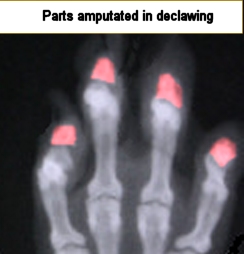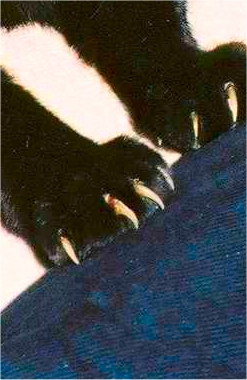Declawing cats

The thought of declawing has crossed the mind of many cat owners, especially those looking at shredded sofas, stockings, or even in some cases, limbs. Surely life would be better for everyone if Tiddles the cat was unable to climb the curtains, eviscerate mice and small birds, and wreak havoc with the wallpaper? There can be no denying that a cat' claws are a nasty weapon, and many cat owners, especially those with indoor cats, maintain that their pet has no need of such in a cosy domestic environment where the biggest threat to the cat is kidney failure from over-pampering.
However, it is worth considering what declawing involves for a cat. The operation, technically known as an onychectomy is in fact an amputation, the cutting off of the end toe joint and the claw attached to it. It is not a minor operation, either in itself, or in the effects on the cat. A cat which has been declawed will be in pain for about a week after the operation, and there is some risk of infection and loss of feeling in the remainder of the paw. Furthermore, the cat is now essentially defenceless, as it is unable to fight (claws and teeth being the cat's main arsenal) or run (as a cat in flight usually sprints to the nearest climbable object). Whilst the owner might firmly believe that his cat will never need to do these things again, the cat does not know this, and the psychological damage can be profound. This might not be immediately obvious, as cats try hard to conceal vulnerability, but it might result in (for example) a cat which once clawed wallpaper now spraying on it instead. Aggressive cats which once scratched might now resort to biting, which given the bacteria farms on most cats' teeth, is hardly an improvement.
Furthermore, using its claws to climb, manipulate objects and scratch are all forms of a cat's natural behaviour. It is for this reason that most animal shelters and vets are opposed to declawing in principle, and why owners who insist on having their cats declawed might be better off rehoming their cats and getting themselves a fluffy toy. This is especially the case as a survey has shown that many owners ask vets that their cats be declawed before they have even considered other alternatives.

Inappropriate scratching behaviour is something that a cat learns early in kittenhood, at about four to five weeks old. For this reason many breeders make sure that kittens have no furnishings available for scratching during this period. At the same time the kitten is encouraged to take it out on a scratching post, and soon learns to associate the urge to scratch with such an item. Scratching leaves a visual mark, which indicates that there is a cat in residence. (Cats are keen on this, owners less so.) It is also a way for the cat to strop its claws on something to remove overgrowth of claws that might otherwise need manual trimming; sometimes to the great distress of cat and owner. Finally, a cat also leaves a scent mark from glands in its paws, which is one reason why even declawed cats will still try to scratch.
The first step in correcting inappropriate scratching is to check whether the cat is reacting to something in its environment, and to see if this can be adjusted. For example a cat may have discovered that assaulting the curtains gets it noticed, and if it is given an allocated play time, the cat will no longer need to aggressively seek attention. There are also training techniques which can often correct a scratching problem. Declawing should only be considered a very last resort. In fact, in Britain declawing is illegal unless it it required for the medical well-being of the cat. Nor will most cat shows allow declawed animals to be exhibited.
An alternative operation, known as deep digital flexor tendonectomy involves slicing apart the tendons which operate the claws, leaving them in place, but inoperable. There are problems with this process as well including the risk of ingrowing claws (like an ingrowing toenail but much more painful) and an increased risk of arthritis. However, the main issue is that the claws keep growing after a tendonectomy, and if they are not regularly trimmed, the owner is back where he started, except that the overgrown claws cannot be retracted. Recently an innovation involving claw covers has proven a good compromise, though many owners quite justifiably ask how they are meant to get the things on in the first place.
A final word on declawing might go to a famous feline cartoon strip.
"Did you take Garfield to get declawed?"
"Yes, the stitches should come out next week"
"Poor Garfield"
"Garfield?"
